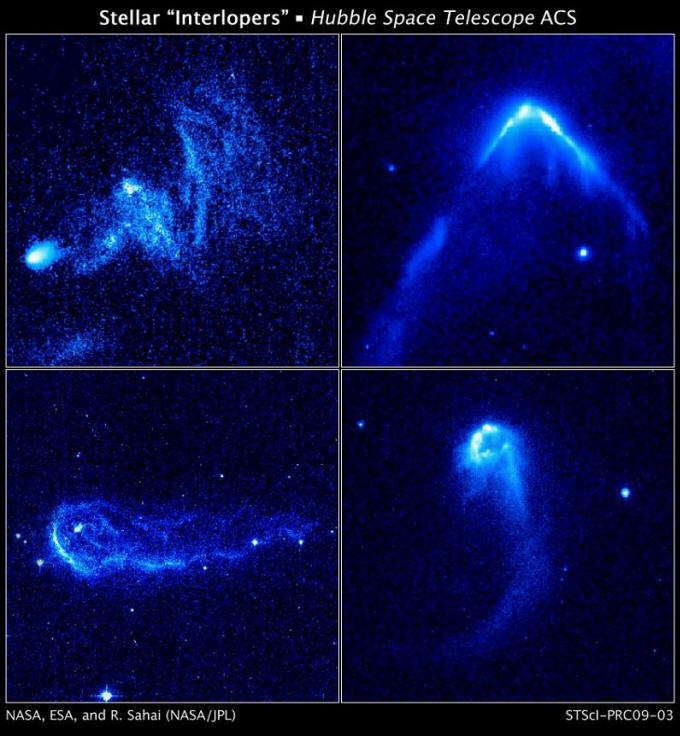|
|
|

Putative stellar "bow shocks." Credit: NASA, ESA,
and R. Sahai, JPL.
Stars in Collision Part 2
May 21, 2010
Astronomers have recently
discovered a band of energetic
neutral atoms around the sky. This
discovery supports the hypothesis
that the Sun captured a previously
independent Saturnian system, in
which Saturn was the brown-dwarf
primary for the planets Earth, Mars,
and Venus.Part 1 described
the first kind of electric star, the
anodic star, formed at the focus of
a z-pinch. The sheath around such a
star would have the shape of an
hourglass, as is seen in planetary
nebulae. Recent observations of
energetic neutral atoms indicate
that the Sunís sheath also has such
a shape.
What about the observations of
comet-like stars? These are seen
in the tangled high-energy
ďshort-circuitĒ discharges of
so-called star-forming regions. If a
star that has a lower positive
charge (with respect to the galactic
plasma) enters the sheath of a
second star that has a higher
positive charge, the first star will
lose its interaction with the
galactic plasma and begin to
interact with the plasma inside the
second starís sheath. The first star
will now have a negative charge with
respect to the second. It will
become a cathodic star and behave as
do other negatively charged bodies
in an anode sheath, such as comets.
It will develop a coma and a tail.
This is the second kind of electric
star.
Furthermore, it will no longer be
subjected to the strong
electromagnetic forces of a z-pinch.
Most of the voltage difference
between a star and the galactic
plasma is contained within the
double layers of the sheath. Inside
the second star's sheath, in what
corresponds to the positive column
of a discharge tube, the electric
field is small. Gravity may become
the dominant force. However, the
weak electric field and the cometary
discharge of the first star combine
to aid capture and stabilization.
The first star begins to orbit the
second, becoming a binary companion
or a gas giant planet.
Judging by the number of observed
comet-like stars, such capture is
not uncommon. Itís probably a safe
assumption that a proportional
number of stars in low-energy dark
mode conditions are also captured.
In other words, capture may be a
frequent occurrence in an electric
universe. This is to be contrasted
with the case in a gravity universe,
in which capture is virtually
impossible:
First, stars are only tiny sparks in
the immensity of space. For example,
at a scale of
one inch to one astronomical
unit (the distance of the Earth from
the Sun), the nearest star would be
four miles away and the Sun would be
the size of a dust mote, about a
hundredth of an inch. The chance of
intersecting orbits is
insignificant.
Second, if the orbits did intersect,
they would be apt to do so at
significant angles to each other.
Relative velocities would be large.
Near-collision orbits would be
hyperbolic, and the two stars would
zip past each other with little
interaction, never to return. If one
actually scored a bullís-eye hit on
the other, one or both bodies would
be destroyed.
Third, if the orbits touched each
other tangentially, relative
velocities would be low, but gravity
would act to perturb the orbits for
less interaction, not for capture.
If electrical capture is common, it
lends credibility to such Saturnist
models of the recent history of the
Solar system as that described by
Dwardu Cardona in his book God Star
and its two sequels. The body that
became Saturn was a brown dwarf star
moving alone in the galaxy with
Venus, Mars, and Earth held in the
axial jet above its poleóa
low-energy counterpart of
Herbig-Haro stars. It was drawn
toward the Sun along the same
galactic current.
When it entered the Sunís sheath,
the electrical readjustment caused
flaring and the disruption of the
axial alignment of planets.
Proto-Saturn lost its stellar
radiance and its planets, and the
bodies soon settled into
quasi-stable orbits among the rest
of the Sunís planets.
Mel Acheson
|
|
|
|
|
|
|
|
|
YouTube video, first glimpses of Episode Two in the "Symbols of an Alien Sky"
series.
|
|
|
|
|
|
|
Three ebooks in the Universe Electric series are
now available. Consistently
praised for easily understandable text and exquisite graphics.
|
|
|
|
|
|
|
|
|
|







